University Annotated Bibliography: Workplace Communication Analysis
VerifiedAdded on 2023/01/04
|7
|1791
|80
Annotated Bibliography
AI Summary
This annotated bibliography examines various facets of workplace communication, drawing on multiple academic articles. It explores the importance of nonverbal communication in fostering productivity and effective operations within organizations, highlighting its role in conveying confidence and enhancing understanding. The bibliography also analyzes the communication preferences of millennial employees, emphasizing their preference for visual and personalized communication styles, and disruptive leadership. Furthermore, the annotated bibliography delves into the significance of emotional intelligence in the workplace, examining how supervisor-employee interactions impact employee motivation and decision-making. It also investigates the impact of symmetrical internal communication on employee engagement and positive communication behaviors, emphasizing the correlation between employee engagement and organizational effectiveness. Finally, the bibliography addresses the rising importance of cross-cultural communication in global business, recognizing language barriers and cultural differences and suggesting the importance of proactively managing interactions to foster business success.
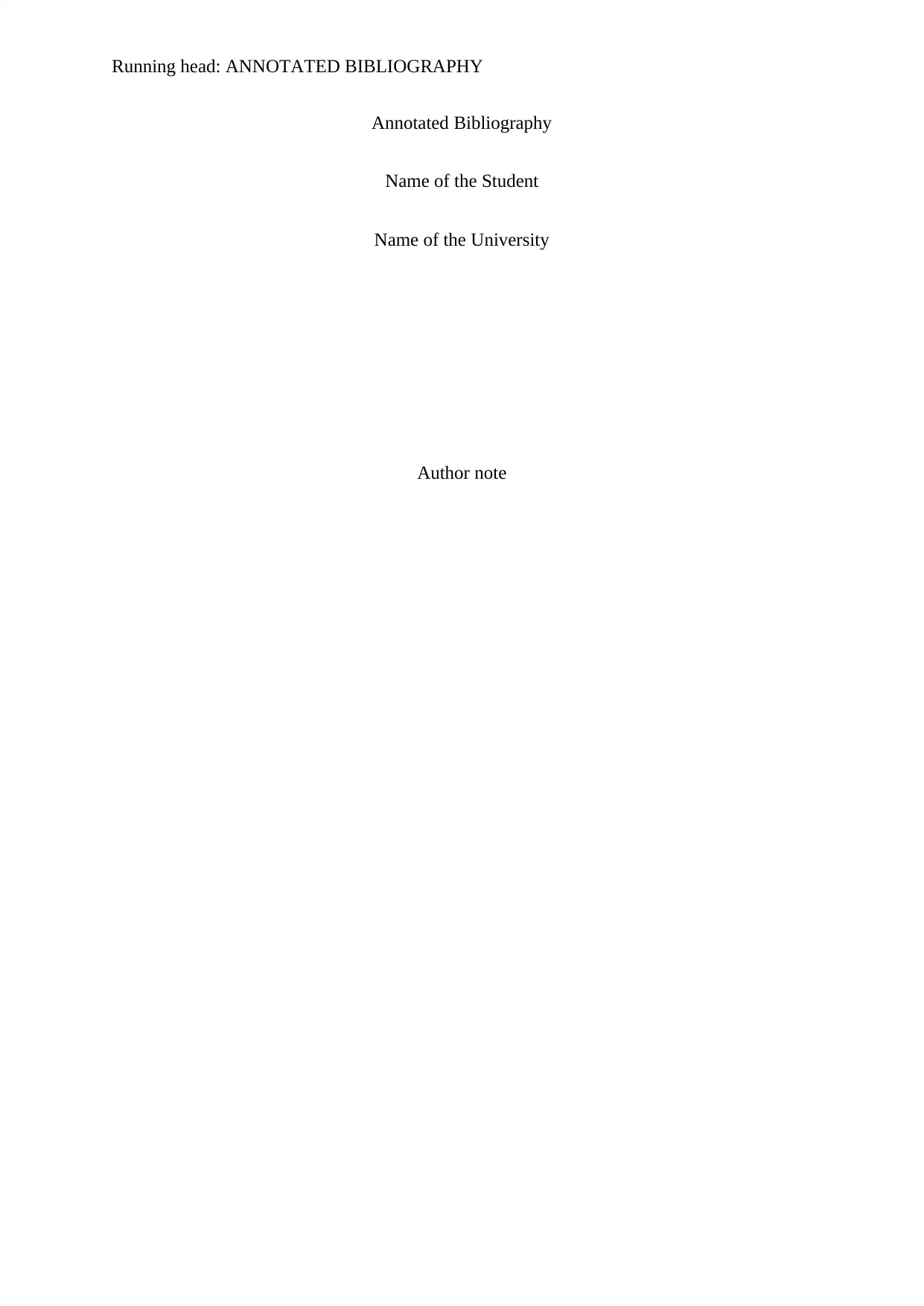
Running head: ANNOTATED BIBLIOGRAPHY
Annotated Bibliography
Name of the Student
Name of the University
Author note
Annotated Bibliography
Name of the Student
Name of the University
Author note
Paraphrase This Document
Need a fresh take? Get an instant paraphrase of this document with our AI Paraphraser
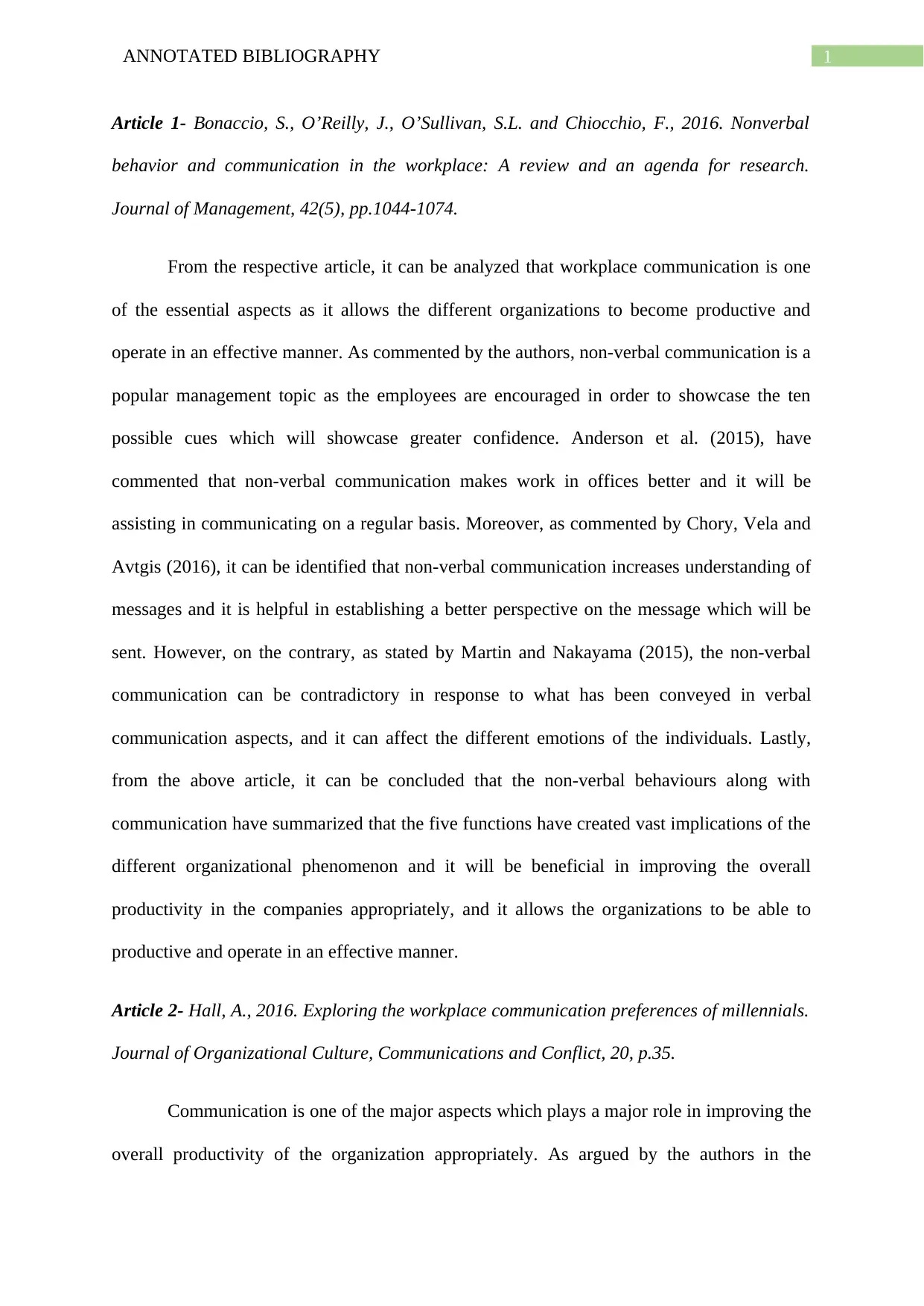
1ANNOTATED BIBLIOGRAPHY
Article 1- Bonaccio, S., O’Reilly, J., O’Sullivan, S.L. and Chiocchio, F., 2016. Nonverbal
behavior and communication in the workplace: A review and an agenda for research.
Journal of Management, 42(5), pp.1044-1074.
From the respective article, it can be analyzed that workplace communication is one
of the essential aspects as it allows the different organizations to become productive and
operate in an effective manner. As commented by the authors, non-verbal communication is a
popular management topic as the employees are encouraged in order to showcase the ten
possible cues which will showcase greater confidence. Anderson et al. (2015), have
commented that non-verbal communication makes work in offices better and it will be
assisting in communicating on a regular basis. Moreover, as commented by Chory, Vela and
Avtgis (2016), it can be identified that non-verbal communication increases understanding of
messages and it is helpful in establishing a better perspective on the message which will be
sent. However, on the contrary, as stated by Martin and Nakayama (2015), the non-verbal
communication can be contradictory in response to what has been conveyed in verbal
communication aspects, and it can affect the different emotions of the individuals. Lastly,
from the above article, it can be concluded that the non-verbal behaviours along with
communication have summarized that the five functions have created vast implications of the
different organizational phenomenon and it will be beneficial in improving the overall
productivity in the companies appropriately, and it allows the organizations to be able to
productive and operate in an effective manner.
Article 2- Hall, A., 2016. Exploring the workplace communication preferences of millennials.
Journal of Organizational Culture, Communications and Conflict, 20, p.35.
Communication is one of the major aspects which plays a major role in improving the
overall productivity of the organization appropriately. As argued by the authors in the
Article 1- Bonaccio, S., O’Reilly, J., O’Sullivan, S.L. and Chiocchio, F., 2016. Nonverbal
behavior and communication in the workplace: A review and an agenda for research.
Journal of Management, 42(5), pp.1044-1074.
From the respective article, it can be analyzed that workplace communication is one
of the essential aspects as it allows the different organizations to become productive and
operate in an effective manner. As commented by the authors, non-verbal communication is a
popular management topic as the employees are encouraged in order to showcase the ten
possible cues which will showcase greater confidence. Anderson et al. (2015), have
commented that non-verbal communication makes work in offices better and it will be
assisting in communicating on a regular basis. Moreover, as commented by Chory, Vela and
Avtgis (2016), it can be identified that non-verbal communication increases understanding of
messages and it is helpful in establishing a better perspective on the message which will be
sent. However, on the contrary, as stated by Martin and Nakayama (2015), the non-verbal
communication can be contradictory in response to what has been conveyed in verbal
communication aspects, and it can affect the different emotions of the individuals. Lastly,
from the above article, it can be concluded that the non-verbal behaviours along with
communication have summarized that the five functions have created vast implications of the
different organizational phenomenon and it will be beneficial in improving the overall
productivity in the companies appropriately, and it allows the organizations to be able to
productive and operate in an effective manner.
Article 2- Hall, A., 2016. Exploring the workplace communication preferences of millennials.
Journal of Organizational Culture, Communications and Conflict, 20, p.35.
Communication is one of the major aspects which plays a major role in improving the
overall productivity of the organization appropriately. As argued by the authors in the
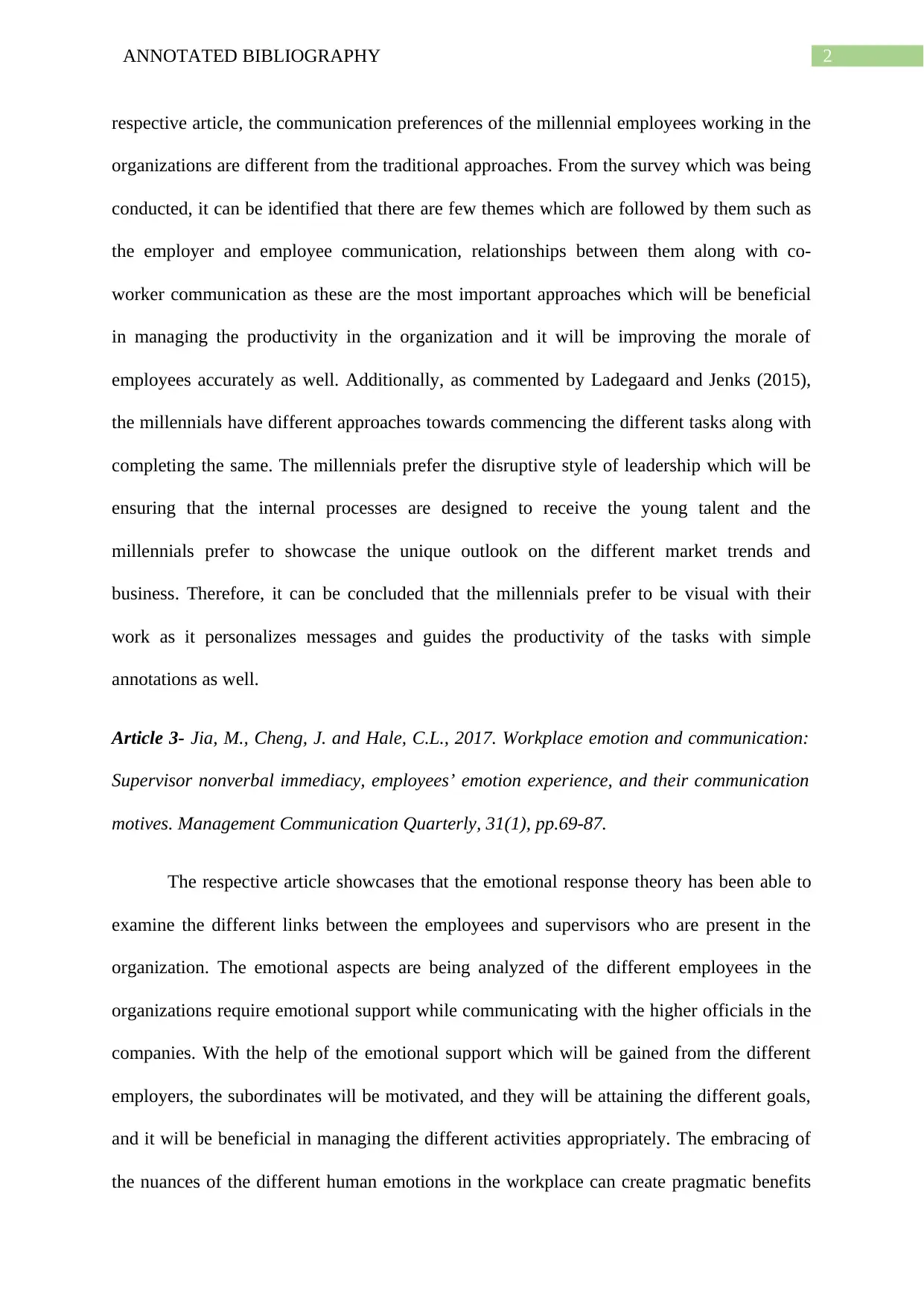
2ANNOTATED BIBLIOGRAPHY
respective article, the communication preferences of the millennial employees working in the
organizations are different from the traditional approaches. From the survey which was being
conducted, it can be identified that there are few themes which are followed by them such as
the employer and employee communication, relationships between them along with co-
worker communication as these are the most important approaches which will be beneficial
in managing the productivity in the organization and it will be improving the morale of
employees accurately as well. Additionally, as commented by Ladegaard and Jenks (2015),
the millennials have different approaches towards commencing the different tasks along with
completing the same. The millennials prefer the disruptive style of leadership which will be
ensuring that the internal processes are designed to receive the young talent and the
millennials prefer to showcase the unique outlook on the different market trends and
business. Therefore, it can be concluded that the millennials prefer to be visual with their
work as it personalizes messages and guides the productivity of the tasks with simple
annotations as well.
Article 3- Jia, M., Cheng, J. and Hale, C.L., 2017. Workplace emotion and communication:
Supervisor nonverbal immediacy, employees’ emotion experience, and their communication
motives. Management Communication Quarterly, 31(1), pp.69-87.
The respective article showcases that the emotional response theory has been able to
examine the different links between the employees and supervisors who are present in the
organization. The emotional aspects are being analyzed of the different employees in the
organizations require emotional support while communicating with the higher officials in the
companies. With the help of the emotional support which will be gained from the different
employers, the subordinates will be motivated, and they will be attaining the different goals,
and it will be beneficial in managing the different activities appropriately. The embracing of
the nuances of the different human emotions in the workplace can create pragmatic benefits
respective article, the communication preferences of the millennial employees working in the
organizations are different from the traditional approaches. From the survey which was being
conducted, it can be identified that there are few themes which are followed by them such as
the employer and employee communication, relationships between them along with co-
worker communication as these are the most important approaches which will be beneficial
in managing the productivity in the organization and it will be improving the morale of
employees accurately as well. Additionally, as commented by Ladegaard and Jenks (2015),
the millennials have different approaches towards commencing the different tasks along with
completing the same. The millennials prefer the disruptive style of leadership which will be
ensuring that the internal processes are designed to receive the young talent and the
millennials prefer to showcase the unique outlook on the different market trends and
business. Therefore, it can be concluded that the millennials prefer to be visual with their
work as it personalizes messages and guides the productivity of the tasks with simple
annotations as well.
Article 3- Jia, M., Cheng, J. and Hale, C.L., 2017. Workplace emotion and communication:
Supervisor nonverbal immediacy, employees’ emotion experience, and their communication
motives. Management Communication Quarterly, 31(1), pp.69-87.
The respective article showcases that the emotional response theory has been able to
examine the different links between the employees and supervisors who are present in the
organization. The emotional aspects are being analyzed of the different employees in the
organizations require emotional support while communicating with the higher officials in the
companies. With the help of the emotional support which will be gained from the different
employers, the subordinates will be motivated, and they will be attaining the different goals,
and it will be beneficial in managing the different activities appropriately. The embracing of
the nuances of the different human emotions in the workplace can create pragmatic benefits
⊘ This is a preview!⊘
Do you want full access?
Subscribe today to unlock all pages.

Trusted by 1+ million students worldwide
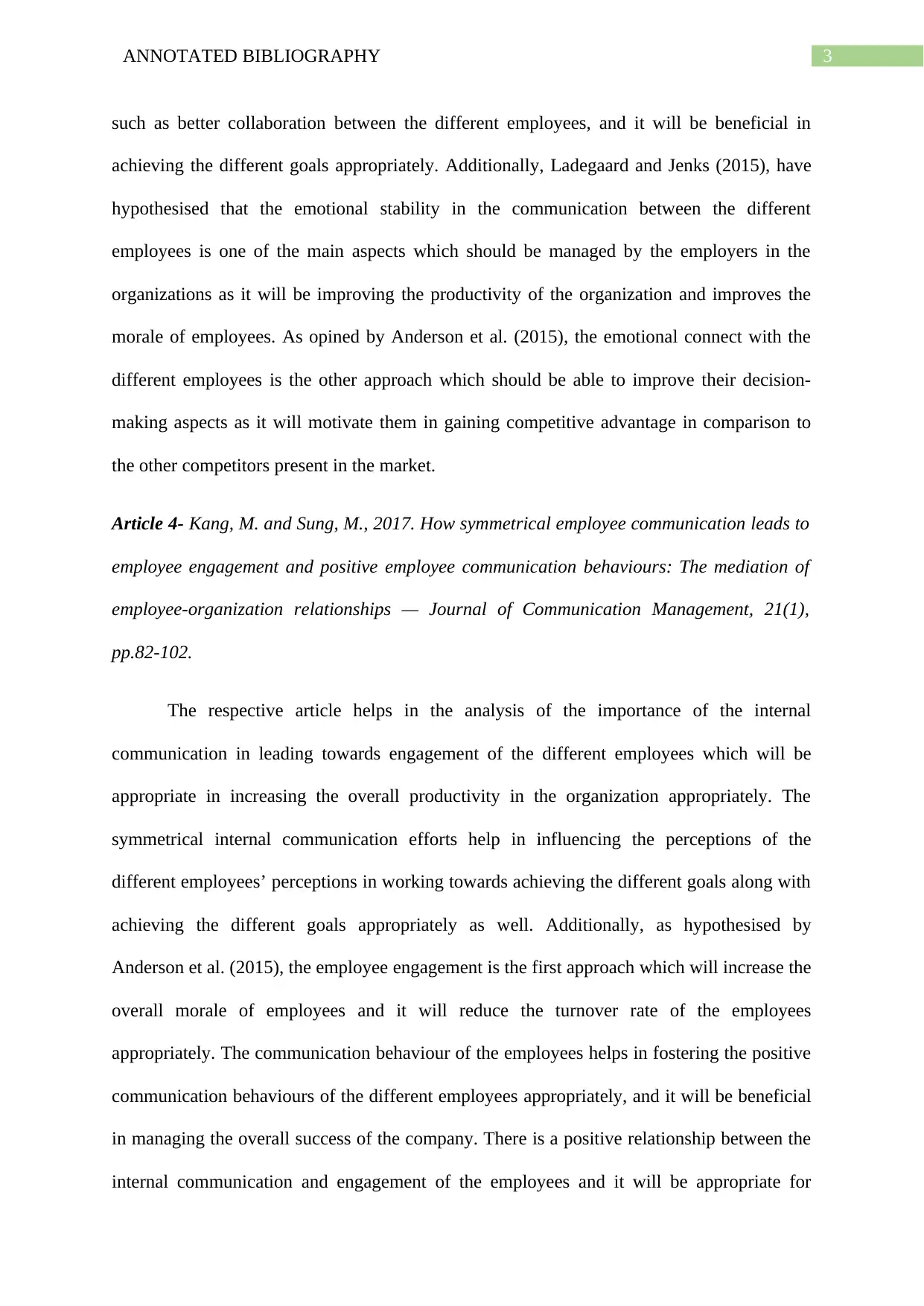
3ANNOTATED BIBLIOGRAPHY
such as better collaboration between the different employees, and it will be beneficial in
achieving the different goals appropriately. Additionally, Ladegaard and Jenks (2015), have
hypothesised that the emotional stability in the communication between the different
employees is one of the main aspects which should be managed by the employers in the
organizations as it will be improving the productivity of the organization and improves the
morale of employees. As opined by Anderson et al. (2015), the emotional connect with the
different employees is the other approach which should be able to improve their decision-
making aspects as it will motivate them in gaining competitive advantage in comparison to
the other competitors present in the market.
Article 4- Kang, M. and Sung, M., 2017. How symmetrical employee communication leads to
employee engagement and positive employee communication behaviours: The mediation of
employee-organization relationships — Journal of Communication Management, 21(1),
pp.82-102.
The respective article helps in the analysis of the importance of the internal
communication in leading towards engagement of the different employees which will be
appropriate in increasing the overall productivity in the organization appropriately. The
symmetrical internal communication efforts help in influencing the perceptions of the
different employees’ perceptions in working towards achieving the different goals along with
achieving the different goals appropriately as well. Additionally, as hypothesised by
Anderson et al. (2015), the employee engagement is the first approach which will increase the
overall morale of employees and it will reduce the turnover rate of the employees
appropriately. The communication behaviour of the employees helps in fostering the positive
communication behaviours of the different employees appropriately, and it will be beneficial
in managing the overall success of the company. There is a positive relationship between the
internal communication and engagement of the employees and it will be appropriate for
such as better collaboration between the different employees, and it will be beneficial in
achieving the different goals appropriately. Additionally, Ladegaard and Jenks (2015), have
hypothesised that the emotional stability in the communication between the different
employees is one of the main aspects which should be managed by the employers in the
organizations as it will be improving the productivity of the organization and improves the
morale of employees. As opined by Anderson et al. (2015), the emotional connect with the
different employees is the other approach which should be able to improve their decision-
making aspects as it will motivate them in gaining competitive advantage in comparison to
the other competitors present in the market.
Article 4- Kang, M. and Sung, M., 2017. How symmetrical employee communication leads to
employee engagement and positive employee communication behaviours: The mediation of
employee-organization relationships — Journal of Communication Management, 21(1),
pp.82-102.
The respective article helps in the analysis of the importance of the internal
communication in leading towards engagement of the different employees which will be
appropriate in increasing the overall productivity in the organization appropriately. The
symmetrical internal communication efforts help in influencing the perceptions of the
different employees’ perceptions in working towards achieving the different goals along with
achieving the different goals appropriately as well. Additionally, as hypothesised by
Anderson et al. (2015), the employee engagement is the first approach which will increase the
overall morale of employees and it will reduce the turnover rate of the employees
appropriately. The communication behaviour of the employees helps in fostering the positive
communication behaviours of the different employees appropriately, and it will be beneficial
in managing the overall success of the company. There is a positive relationship between the
internal communication and engagement of the employees and it will be appropriate for
Paraphrase This Document
Need a fresh take? Get an instant paraphrase of this document with our AI Paraphraser
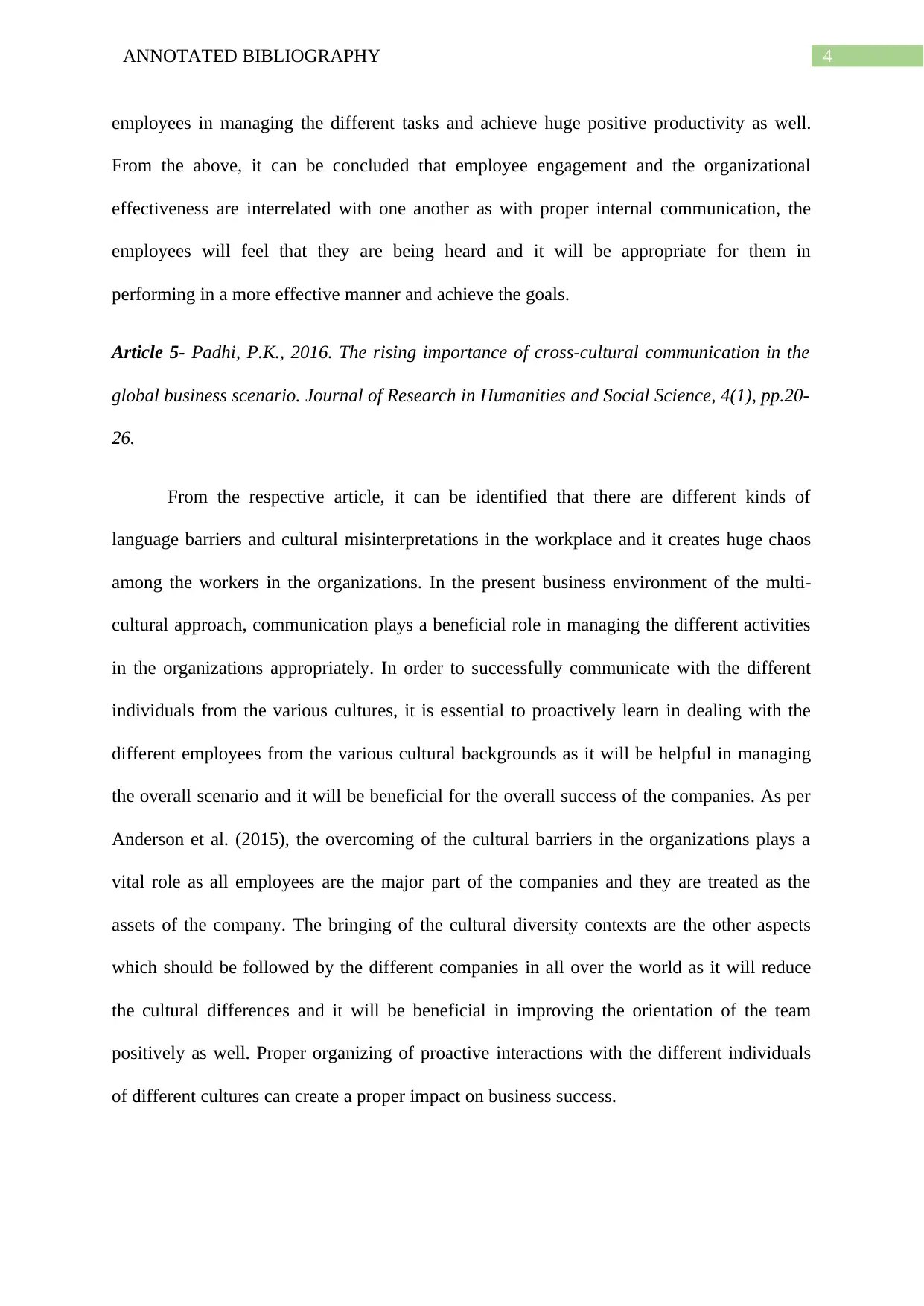
4ANNOTATED BIBLIOGRAPHY
employees in managing the different tasks and achieve huge positive productivity as well.
From the above, it can be concluded that employee engagement and the organizational
effectiveness are interrelated with one another as with proper internal communication, the
employees will feel that they are being heard and it will be appropriate for them in
performing in a more effective manner and achieve the goals.
Article 5- Padhi, P.K., 2016. The rising importance of cross-cultural communication in the
global business scenario. Journal of Research in Humanities and Social Science, 4(1), pp.20-
26.
From the respective article, it can be identified that there are different kinds of
language barriers and cultural misinterpretations in the workplace and it creates huge chaos
among the workers in the organizations. In the present business environment of the multi-
cultural approach, communication plays a beneficial role in managing the different activities
in the organizations appropriately. In order to successfully communicate with the different
individuals from the various cultures, it is essential to proactively learn in dealing with the
different employees from the various cultural backgrounds as it will be helpful in managing
the overall scenario and it will be beneficial for the overall success of the companies. As per
Anderson et al. (2015), the overcoming of the cultural barriers in the organizations plays a
vital role as all employees are the major part of the companies and they are treated as the
assets of the company. The bringing of the cultural diversity contexts are the other aspects
which should be followed by the different companies in all over the world as it will reduce
the cultural differences and it will be beneficial in improving the orientation of the team
positively as well. Proper organizing of proactive interactions with the different individuals
of different cultures can create a proper impact on business success.
employees in managing the different tasks and achieve huge positive productivity as well.
From the above, it can be concluded that employee engagement and the organizational
effectiveness are interrelated with one another as with proper internal communication, the
employees will feel that they are being heard and it will be appropriate for them in
performing in a more effective manner and achieve the goals.
Article 5- Padhi, P.K., 2016. The rising importance of cross-cultural communication in the
global business scenario. Journal of Research in Humanities and Social Science, 4(1), pp.20-
26.
From the respective article, it can be identified that there are different kinds of
language barriers and cultural misinterpretations in the workplace and it creates huge chaos
among the workers in the organizations. In the present business environment of the multi-
cultural approach, communication plays a beneficial role in managing the different activities
in the organizations appropriately. In order to successfully communicate with the different
individuals from the various cultures, it is essential to proactively learn in dealing with the
different employees from the various cultural backgrounds as it will be helpful in managing
the overall scenario and it will be beneficial for the overall success of the companies. As per
Anderson et al. (2015), the overcoming of the cultural barriers in the organizations plays a
vital role as all employees are the major part of the companies and they are treated as the
assets of the company. The bringing of the cultural diversity contexts are the other aspects
which should be followed by the different companies in all over the world as it will reduce
the cultural differences and it will be beneficial in improving the orientation of the team
positively as well. Proper organizing of proactive interactions with the different individuals
of different cultures can create a proper impact on business success.
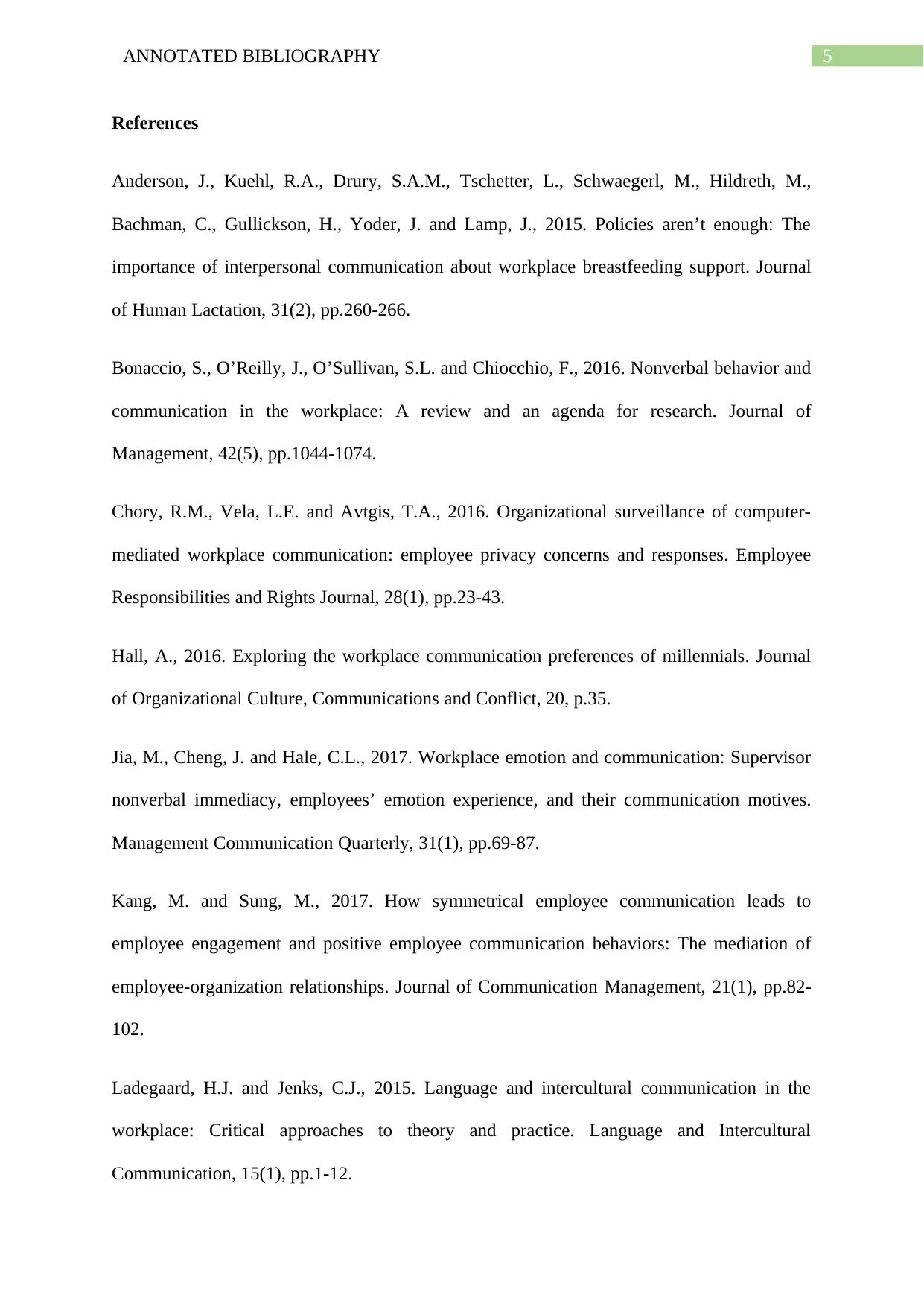
5ANNOTATED BIBLIOGRAPHY
References
Anderson, J., Kuehl, R.A., Drury, S.A.M., Tschetter, L., Schwaegerl, M., Hildreth, M.,
Bachman, C., Gullickson, H., Yoder, J. and Lamp, J., 2015. Policies aren’t enough: The
importance of interpersonal communication about workplace breastfeeding support. Journal
of Human Lactation, 31(2), pp.260-266.
Bonaccio, S., O’Reilly, J., O’Sullivan, S.L. and Chiocchio, F., 2016. Nonverbal behavior and
communication in the workplace: A review and an agenda for research. Journal of
Management, 42(5), pp.1044-1074.
Chory, R.M., Vela, L.E. and Avtgis, T.A., 2016. Organizational surveillance of computer-
mediated workplace communication: employee privacy concerns and responses. Employee
Responsibilities and Rights Journal, 28(1), pp.23-43.
Hall, A., 2016. Exploring the workplace communication preferences of millennials. Journal
of Organizational Culture, Communications and Conflict, 20, p.35.
Jia, M., Cheng, J. and Hale, C.L., 2017. Workplace emotion and communication: Supervisor
nonverbal immediacy, employees’ emotion experience, and their communication motives.
Management Communication Quarterly, 31(1), pp.69-87.
Kang, M. and Sung, M., 2017. How symmetrical employee communication leads to
employee engagement and positive employee communication behaviors: The mediation of
employee-organization relationships. Journal of Communication Management, 21(1), pp.82-
102.
Ladegaard, H.J. and Jenks, C.J., 2015. Language and intercultural communication in the
workplace: Critical approaches to theory and practice. Language and Intercultural
Communication, 15(1), pp.1-12.
References
Anderson, J., Kuehl, R.A., Drury, S.A.M., Tschetter, L., Schwaegerl, M., Hildreth, M.,
Bachman, C., Gullickson, H., Yoder, J. and Lamp, J., 2015. Policies aren’t enough: The
importance of interpersonal communication about workplace breastfeeding support. Journal
of Human Lactation, 31(2), pp.260-266.
Bonaccio, S., O’Reilly, J., O’Sullivan, S.L. and Chiocchio, F., 2016. Nonverbal behavior and
communication in the workplace: A review and an agenda for research. Journal of
Management, 42(5), pp.1044-1074.
Chory, R.M., Vela, L.E. and Avtgis, T.A., 2016. Organizational surveillance of computer-
mediated workplace communication: employee privacy concerns and responses. Employee
Responsibilities and Rights Journal, 28(1), pp.23-43.
Hall, A., 2016. Exploring the workplace communication preferences of millennials. Journal
of Organizational Culture, Communications and Conflict, 20, p.35.
Jia, M., Cheng, J. and Hale, C.L., 2017. Workplace emotion and communication: Supervisor
nonverbal immediacy, employees’ emotion experience, and their communication motives.
Management Communication Quarterly, 31(1), pp.69-87.
Kang, M. and Sung, M., 2017. How symmetrical employee communication leads to
employee engagement and positive employee communication behaviors: The mediation of
employee-organization relationships. Journal of Communication Management, 21(1), pp.82-
102.
Ladegaard, H.J. and Jenks, C.J., 2015. Language and intercultural communication in the
workplace: Critical approaches to theory and practice. Language and Intercultural
Communication, 15(1), pp.1-12.
⊘ This is a preview!⊘
Do you want full access?
Subscribe today to unlock all pages.

Trusted by 1+ million students worldwide
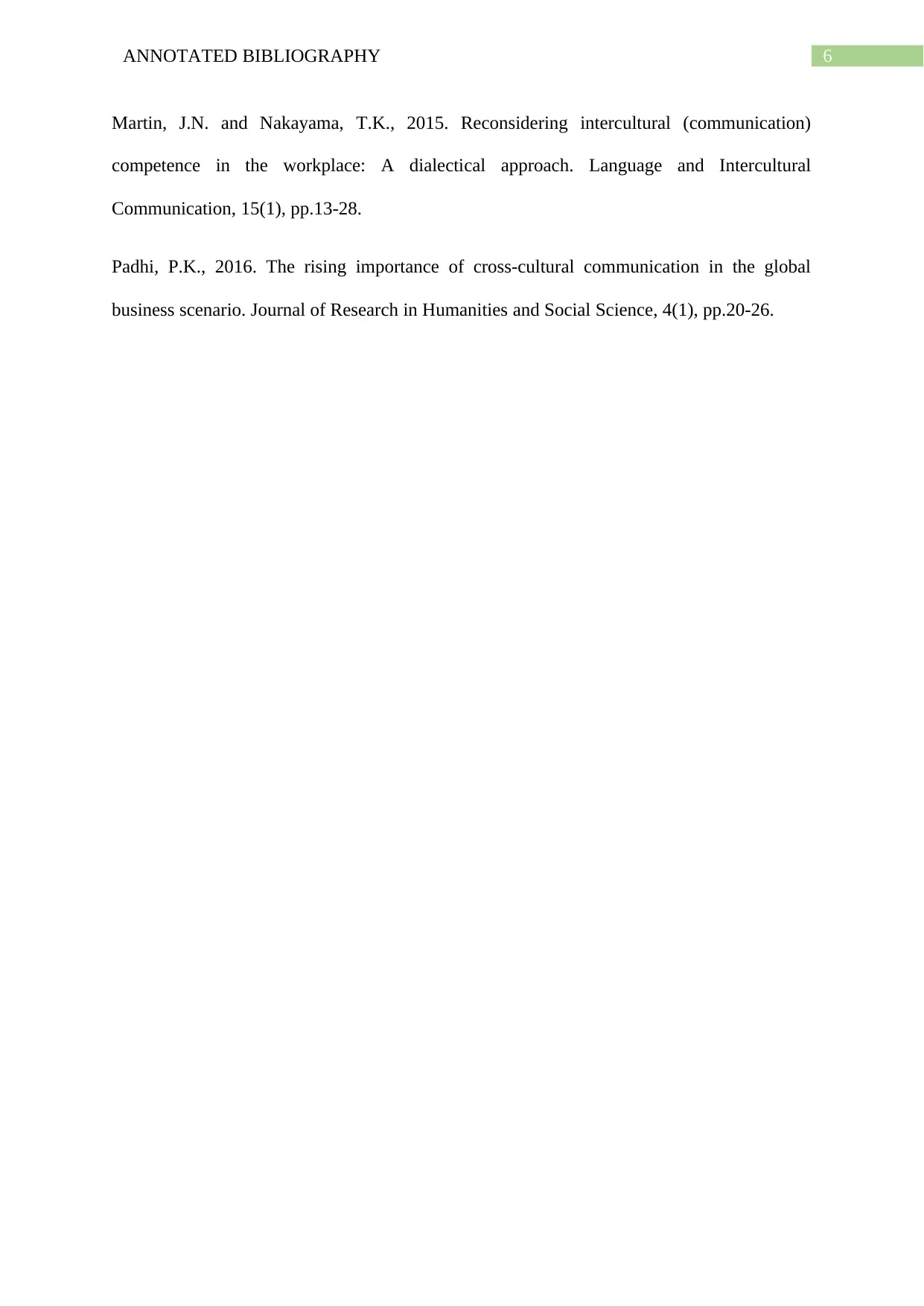
6ANNOTATED BIBLIOGRAPHY
Martin, J.N. and Nakayama, T.K., 2015. Reconsidering intercultural (communication)
competence in the workplace: A dialectical approach. Language and Intercultural
Communication, 15(1), pp.13-28.
Padhi, P.K., 2016. The rising importance of cross-cultural communication in the global
business scenario. Journal of Research in Humanities and Social Science, 4(1), pp.20-26.
Martin, J.N. and Nakayama, T.K., 2015. Reconsidering intercultural (communication)
competence in the workplace: A dialectical approach. Language and Intercultural
Communication, 15(1), pp.13-28.
Padhi, P.K., 2016. The rising importance of cross-cultural communication in the global
business scenario. Journal of Research in Humanities and Social Science, 4(1), pp.20-26.
1 out of 7
Related Documents
Your All-in-One AI-Powered Toolkit for Academic Success.
+13062052269
info@desklib.com
Available 24*7 on WhatsApp / Email
![[object Object]](/_next/static/media/star-bottom.7253800d.svg)
Unlock your academic potential
Copyright © 2020–2025 A2Z Services. All Rights Reserved. Developed and managed by ZUCOL.




